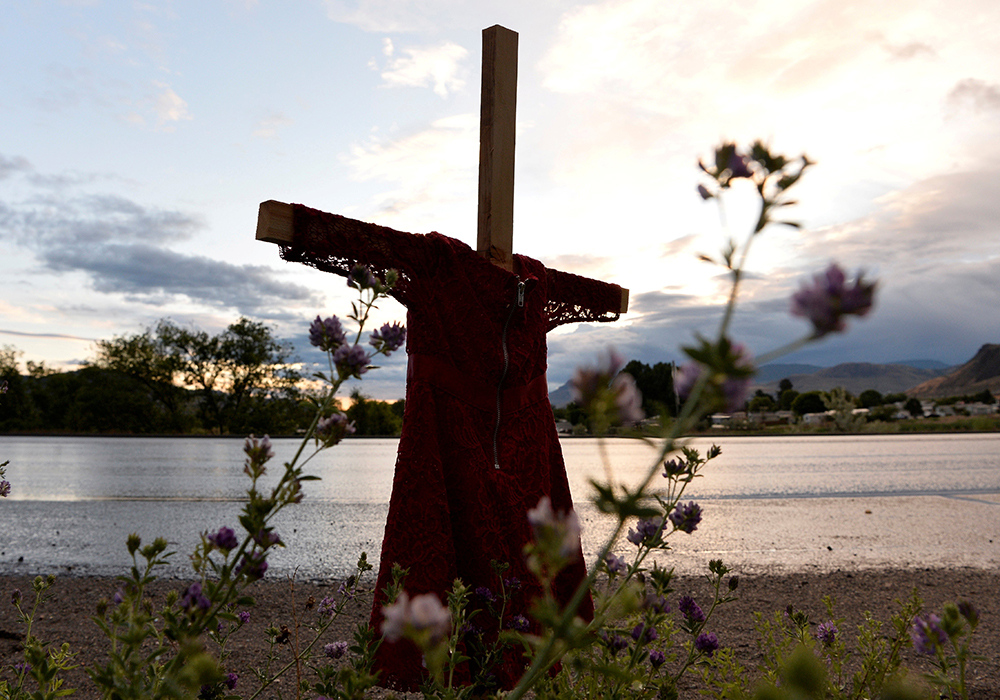
A child's red dress hangs on a stake near the grounds of the former Kamloops Indian Residential School in Kamloops, British Columbia June 5, 2021. For years Indigenous people in Canada wanted an apology from the pope for the church's role in abuse at Catholic-run residential schools. Pope Francis came to Canada in July 2022 for a six-day "penitential pilgrimage" that had long been awaited by survivors. (CNS/Reuters/Jennifer Gauthier)
On a frigid February morning in 2013, Sr. Renelle Lasalle sat next to her friend Monique A. Papatie in a hotel conference center in Val-d'Or, a mining town in the western Quebec region of Abitibi where the Truth and Reconciliation Commission of Canada (known as TRC) was holding a two-day hearing.
A retired educator and a respected figure in the nearby Algonquin Anishinaabe, Papatie was there to share her experience as a student at an Indian residential school in the 1950s and the impact it had on the rest of her life. (Canadians refer to boarding schools as residential schools.)
A decade later, Canada's reconciliation still feels elusive, but Lasalle remembers that day vividly. It was not just the horror stories she heard. It was also the love she felt from the women who had invited her to attend.
"They said, 'We are going to testify, but you are so sensitive that one will sit on your right side, one on your left side, to support you,' " she recalled.
Before sharing painful memories, Papatie paid a tribute to her mother, who had just spoken. Papatie described how the clothes she'd picked for that day were giving her strength. And she introduced the two women she'd invited by her side: her niece, and Lasalle, who by then had been doing missionary work in Lac Simon and Kitcisakik for more than two years.
"Why did I choose a sister?" Papatie said. "It's my own way to give forgiveness, because sisters did us a lot of harm in residential schools."
For more than a century, Canada sponsored boarding schools that cut off more than 150,000 First Nations, Métis and Inuit children from their communities to assimilate them into the dominant culture, which it now has recognized as an act of genocide. Still in shock from leaving their family, students were stripped of their belongings, assigned a number, and told not to speak their language. In thousands of testimonies gathered by the TRC across the country, survivors told stories of neglect, abuse, and racism — traumas that have had long-lasting consequences on them and their families.
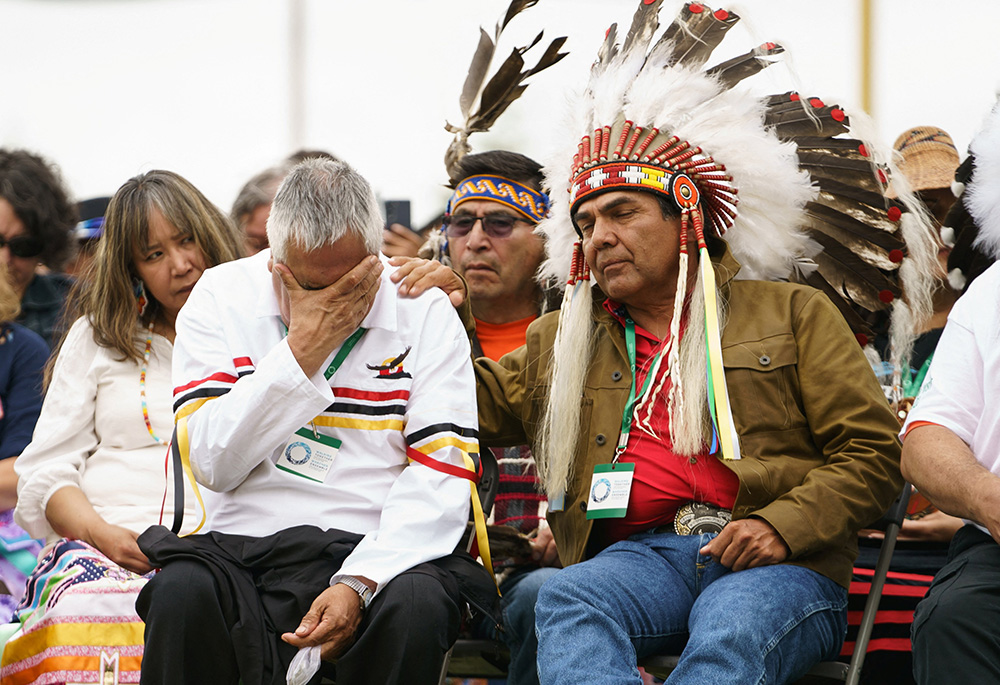
A man is comforted by an Indigenous leader during ceremonies in Maskwacis, Alberta, July 25, 2022, where Pope Francis apologized to Canada's native people on their land for the church's role in schools where Indigenous children were abused. (CNS/Adam Scotti, Prime Minister's Office handout via Reuters)
Churches stood at the center of it. Before the government started winding them down in 1969, it had delegated the management of Indian residential schools to Christian denominations, clergymen and women religious, mostly Catholic. Hundreds of Catholic nuns, called on to serve as teachers and caretakers, played a crucial part in a low-cost, poorly funded system. In TRC testimonies, many come across as cold, harsh, quick to physically punish and unsupportive of sexual assault victims.
A year ago, Pope Francis came to Canada on a six-day "penitential pilgrimage" that had long been awaited by survivors. While he apologized for the "cultural destruction" of Indigenous peoples and the role of some Christian and Catholic communities in the practice, he was criticized by some for not going far enough in recognizing the responsibility of the church and for failing, at first, to acknowledge the sexual abuse that went on in the schools.
In the wake of his visit, Global Sisters Report set out to look into reconciliation efforts taking place within religious communities in Canada. It took months of research and more than a dozen interviews to start understanding what is happening both on the ground and in the hearts of sisters.
It is uncomfortable, taboo almost, to talk about the pain sisters may feel around residential schools, especially when their congregations contributed to the suffering of thousands of children it had vowed to take care of. In committing to reconciliation, sisters have had to come to terms with that overshadowing legacy.
"We were part of something that was damaging. Were we knowingly part of it? As far as we can figure out, we were not. Did we intend that? No, of course, we didn't intend it," said Sr. Marie Zarowny, president and board chair of the Sisters of St. Ann, which helped run four residential schools. "I'm not denying that it has been a struggle, and it continues to be a struggle for some sisters."
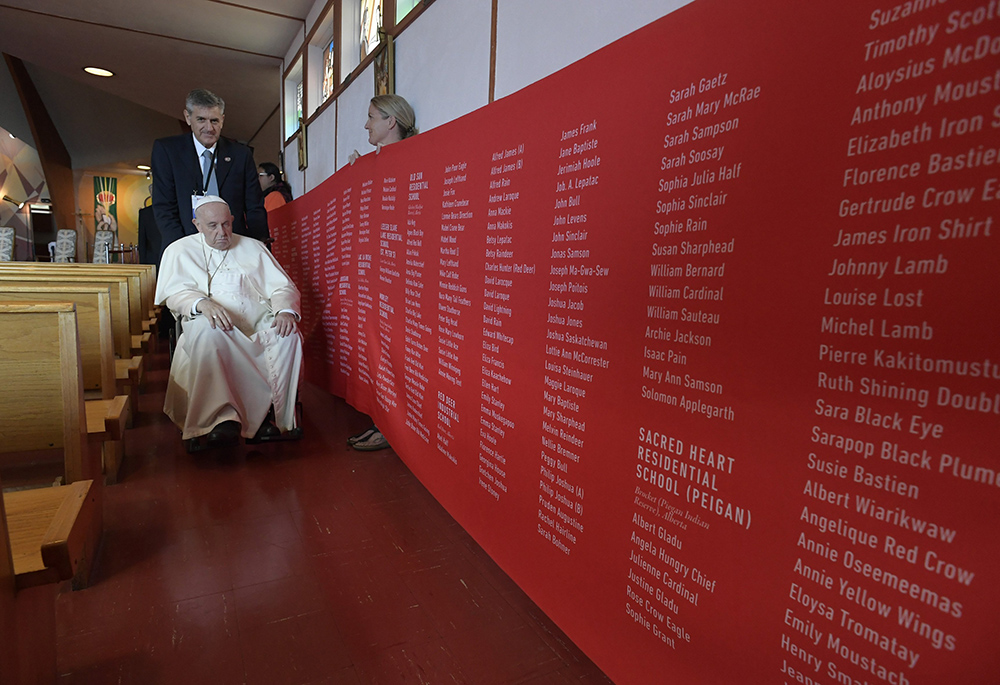
Pope Francis prays in front of a banner bearing the names of each of the 4,120 Indigenous children and the residential school where they died, in this photo from his visit to Maskwacis, Alberta, July 25, 2022. (CNS/Vatican Media)
Lasalle's congregation, Les Soeurs des Saints Coeurs de Jésus et de Marie (The Sisters of the Holy Hearts of Jesus and Mary), was never involved in the schools. Like most Canadians, she knew little about their legacy until the 2000s. As she started hearing stories from survivors in Abitibi, who couldn't remember any happy memories with the sisters, she went through a range of emotions. Denial. Distress that would keep her up at night.
She decided to do her own research within the community. "I asked them, 'Surely there must have been some who were nice?' I asked four different people, the four said the same: 'As soon as they started being humane, they would be sent back.' "
At first, she felt anger at religious people who left such trauma in their wake. It took her time to forgive them.
"It was as if they were undoing all my work," she added. "I thought, 'They worked against the Gospel!' "
Reflecting on the schools and on the church in the context of the 1950s, she imagined that the priests and sisters thought the severity was necessary to prepare the children for life in a white society. The judgment and condemnation are now a bitter legacy for congregations of sisters involved in the boarding schools, she acknowledges.
"It is hard, when you gave your life, to be told you did a genocide. I think the majority meant well. I can't imagine you do that because you hate someone."
When she arrived in Lac Simon in 2010, only three or four people regularly attended Mass. When she left a decade later, the bond she had built with the community, through shared joys and tragedies, went well beyond the 30 or so churchgoers. More than 200 people came to send her off.
"I know the suffering and the strength of these people," said Lasalle, who is still in close touch with Papatie. "This changed my life. I learned what being human means."
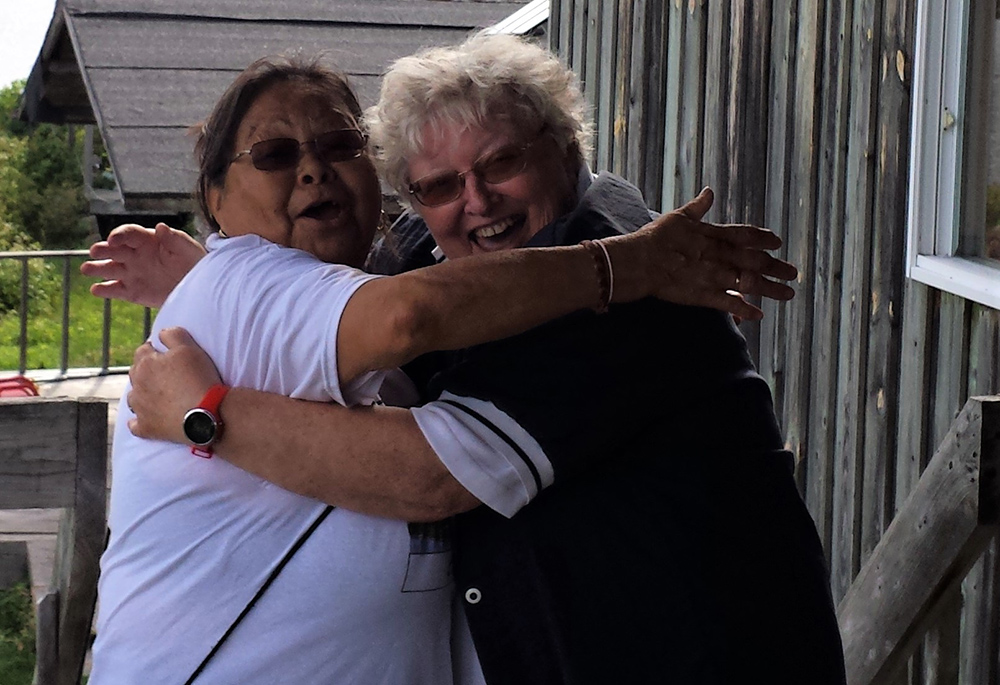
Monique A. Papatie and Sr. Renelle Lasalle are pictured in 2019, after celebrations of the Kitcisakik chapel's 156th anniversary. (Courtesy of Sr. Renelle Lasalle)
Mosaic of initiatives
Since a class-action settlement was signed in 2006 between the government, churches, representatives of former students and Indigenous organizations, Canada has embarked on a long path to reconciliation. Sisters are charting one too.
The scope of their actions, though, is hard to measure. Their efforts dealing with the residential school repercussions resemble a mosaic of initiatives that vary in size and visibility, depending on their age, background, and personal journey.
Sometimes it is just one person in a community who's deeply committed to reconciliation, like Lasalle. Sometimes, several congregations come together to support an Indigenous-led project or form an advocacy group. Other times, reconciliation isn't high on the agenda, possibly because these congregations are busy securing their future as their numbers dwindle, or don't feel bound by a history they took no part in.
"These are issues that challenge our vision of what the church is," said Montreal-based Sabrina Di Matteo, who until a few weeks ago was executive assistant at the Canadian Religious Conference, an association of some 240 congregations. "Is there a collective responsibility, even if a given community didn't have a direct responsibility in a residential school?"
While there is currently no pan-Canadian strategy on reconciliation, the conference's team is reflecting on how to help establish a few guiding principles congregations could rally around, said Di Matteo, who still consults for the organization.
Advertisement
Initiatives can be hard to track. But even harder to capture is the emotional healing taking place in the background, particularly in communities dealing with their history.
The Truth and Reconciliation Commission of Canada, which was established as part of the settlement, gave survivors a chance to tell their story, sometimes for the first time, so that Canadians would understand the history and ongoing legacy of the schools. Its mandate was also to "guide and inspire a process of truth and healing, leading toward reconciliation."
"We're at the truth and healing part," said Sr. Sheila Smith, who teaches a course on the church and Indigenous peoples at St. Paul University in Ottawa. "Indigenous peoples have their own work to do on healing and truth-telling. And non-Indigenous peoples have their work to do, which is different, completely different, on accepting the truths, and doing their own healing. "
To Smith, who hails from the Society of the Sacred Heart (which was not involved in residential schools) and has worked with Indigenous communities for decades, that step can help redefine the relationship.
"There's a whole debate around 'Can this relationship be reconciled, when there really wasn't a relationship to begin with, when it was a relation of domination?' " she said. "I do believe reconciliation involves our own reconciliation, looking at our own identity and who we want to be in this relationship," she added.
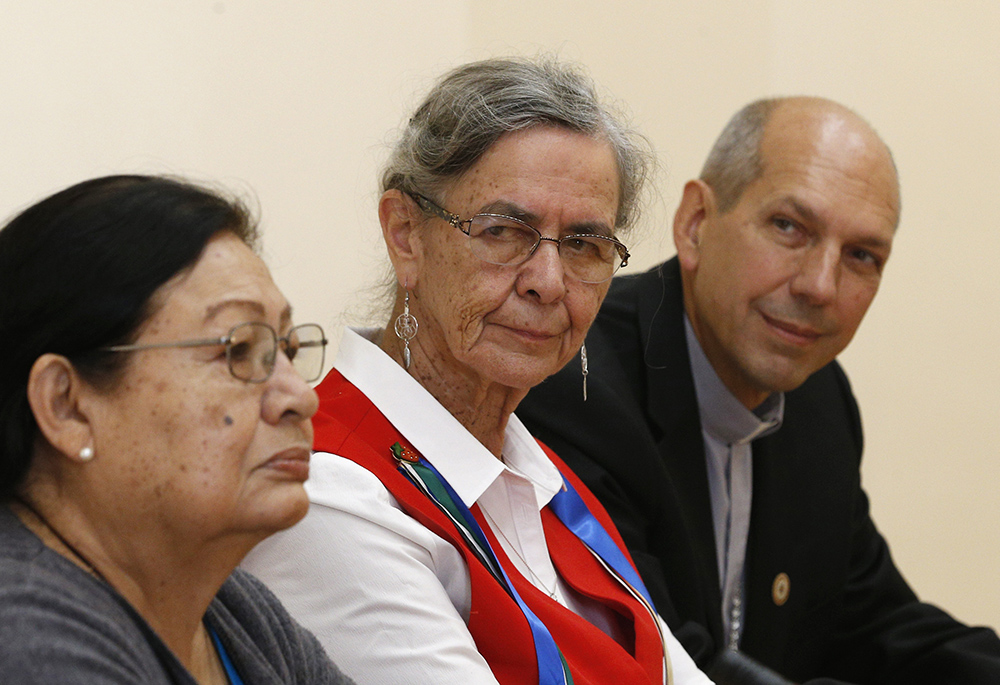
Rita Means, tribal council representative with the Rosebud Sioux Tribe, Sr. Priscilla Solomon, a member of the Ojibway people and of the Sisters of St. Joseph of Sault Ste. Marie, and Archbishop Donald Bolen of Regina, Saskatchewan, attend a news conference with Indigenous leaders from North America Oct. 17, 2019, in Rome. (CNS/Paul Haring)
Making peace with the past
Sr. Priscilla Solomon knows healing follows its own pace. She and her sister, Eva, are Ojibway members of the Anishinabek Nation and belong to the congregation of St. Joseph of Sault Ste. Marie, which until 1966 operated a boarding school for orphans, later classified as a residential school, in Fort William, Ontario (now part of Thunder Bay). From that unique perspective, they kept working on issues of social justice for Indigenous people, even after the congregation became involved in settlement talks. But they witnessed how the process affected some non-Indigenous nuns and held them back from engaging in reconciliation, she said.
For Solomon, the accusations were a shock too. She had never worked at the school but she knew sisters there, and recalled witnessing happy moments with the children when she had visited. The congregation was deeply affected but couldn't discuss it, or offer comfort, because of legal restrictions, she recalled. Many sisters, who had never even lived in Thunder Bay, felt everyone was being painted with the same brush, and all schools declared guilty.
"It took a while for us to come to a point where we could acknowledge that we ourselves needed some really deep healing around that experience," Solomon said. "We were not ready, as a congregation, and individually for many of our sisters, to be involved in the truth and reconciliation process."
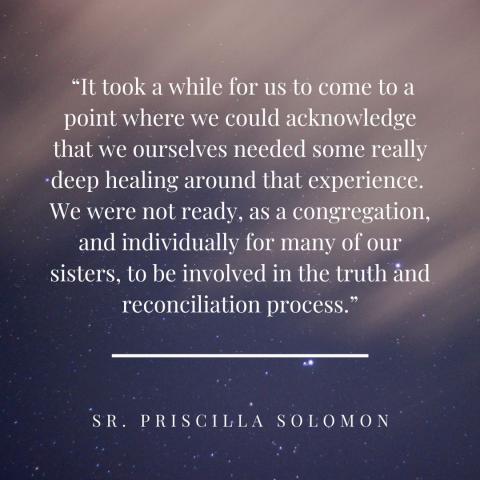
Following its 2018 chapter, leadership put together a dedicated team. It organized regional gatherings, with prayers and reflections, where attendees heard from a sister who had faced an accusation that was later dismissed, and from Solomon's sister, Eva. A retreat for all 90 Sisters, focused on reconciliation, followed a few months later. The congregation now seems more at peace with its past and with its future involvement, Solomon said.
Meanwhile, Solomon had her own reconciliation to go through: as a Christian, recognizing the desire to serve and the racism that have both existed in the church, and as an Indigenous person. She connected with spiritual practices that were once forbidden to Catholics, such as the sweat lodge, smudging or praying with the pipe.
"I saw the good in those and experienced healing from that," Solomon said. "So, I know personally that both of those paths were good paths, and I can bring those paths together."
Opening up the conversation
From the U.S., where information about Native American boarding schools is only starting to emerge, Canada looks quite advanced in its reconciliation efforts. The government apologized over the schools in 2008. It adopted the United Nations Declaration on the Rights of Indigenous Peoples and a National Day for Truth and Reconciliation. Testimonies and Indigenous-led productions have raised awareness about the schools.
In everyday life, however, Canada's colonial legacy continues to impact Indigenous peoples, who face socioeconomic marginalization and discrimination everywhere from hospitals to courts. Indigenous women and girls are 12 times more likely to be murdered or missing than any other women in the country. Of the 94 calls to action for governments, faith groups and communities that the TRC released in 2015, only 13 were completed by the end of 2022, seven years since the report, according to Yellowhead Institute.
Specifically, call No. 58 for a papal apology to residential school survivors, their families, and communities has not been answered, despite Pope Francis' penitential visit to Canada a year ago, according to the Toronto-based, Indigenous-led research and education center.
The apology was helpful to some, but interviews and media reports suggest there was also disappointment among attendees, including after seeing church dignitaries in the front seats, and survivors in the back or outside in the heat, during the Quebec stop.
Still, the visit marked a shift. Eight months later, the Vatican followed up with a move Indigenous groups had long asked for: it repudiated the "Doctrine of Discovery," a collection of 15th-century papal teachings that European powers leaned on to justify colonization. Most recently, the pope opened the door to returning Indigenous artifacts from the Vatican Museums.
"For me, it started to open up the conversation," said Gerald Antoine, Northwest Territories regional chief of the Assembly of First Nations, or AFN, an advocacy organization.
Antoine led an AFN delegation of leaders and residential school survivors who met with the pope at the Vatican last year. In the Sistine Chapel, there was something in the fresco painting by Michelangelo, the "Creation of Adam," that reminded him of the relationship between Indigenous peoples and the church: Adam's and God's index fingers pointing out, almost touching.
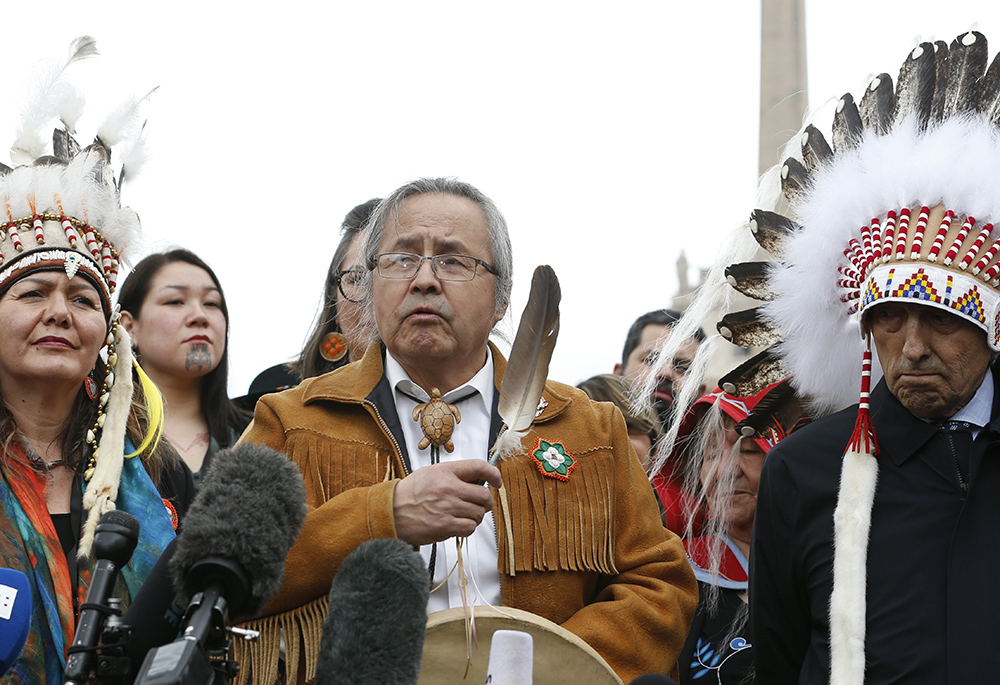
Chief Gerald Antoine, center, Northwest Territories regional chief of the Assembly of First Nations, speaks as First Nations delegates meet the media outside St. Peter's Square after a meeting with Pope Francis March 31, 2022, at the Vatican. Also pictured are Rosanne Casimir, chief of the Tk'emlúps te Secwépemc, and Phil Fontaine, former national chief of the Assembly of First Nations. (CNS/Paul Haring)
Three other fingers are pointing back, symbolizing a need to reflect on oneself and on the situation, he said. Asked whether reconciliation with the church was now closer, Antoine used an analogy honoring his community's close relationship to the land.
The pope's words were akin to coming upon "fresh tracks" when one is out looking for food, he said. "It's not there yet, but at least you need to acknowledge it's fresh tracks, and you need to continue."
Painful reminders
There are hurdles, still, to overcoming distrust. For instance, the church didn't disburse the full amount it had committed to paying in the 2006 settlement agreement (in part because its fundraising campaign fell short of its goal) and was released from its obligations, in court, at a fraction of the cost. In 2021, the Canadian Conference of Catholic Bishops tried to make up for it with a new CA$30 million pledge to fund healing and reconciliation initiatives, in consultation with Indigenous peoples. It's not clear it will reach its financial target this time either.
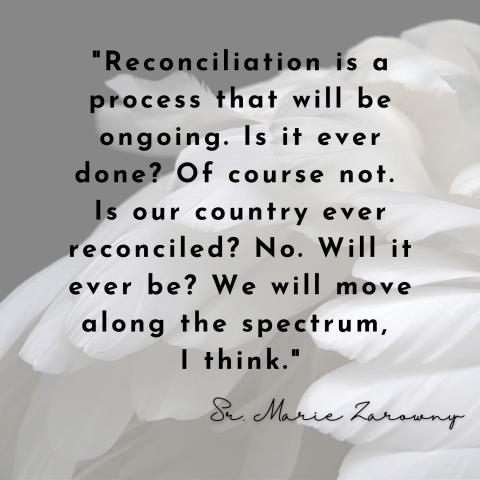
"The great paradox of the residential school history, and of today's situation, is that churches participated in this partnership at a time when they had a lot of power — they had a very strong influence on society," said Jean-Francois Roussel, a professor of religious studies at the Université de Montréal. "Now they must repair, at a time when they are at the margin of society. They can't have the impact they would have had in the 1950s or 1960s."
Unanswered questions about residential schools are also making reconciliation more elusive. Thousands of students never returned home, with their families often left in the dark over what happened to them or where their body was laid to rest. Using technology such as ground penetrating radars, Indigenous communities have been searching the grounds for unmarked burial sites that could provide answers. Each discovery is an emotional trigger.
That was especially striking in May 2021, when radars located possible unmarked graves of as many as 215 children outside the former residential school of Kamloops, once the country's largest in British Columbia. The widely covered news shook the whole nation, bringing history back to the forefront and prompting lots of reactions.
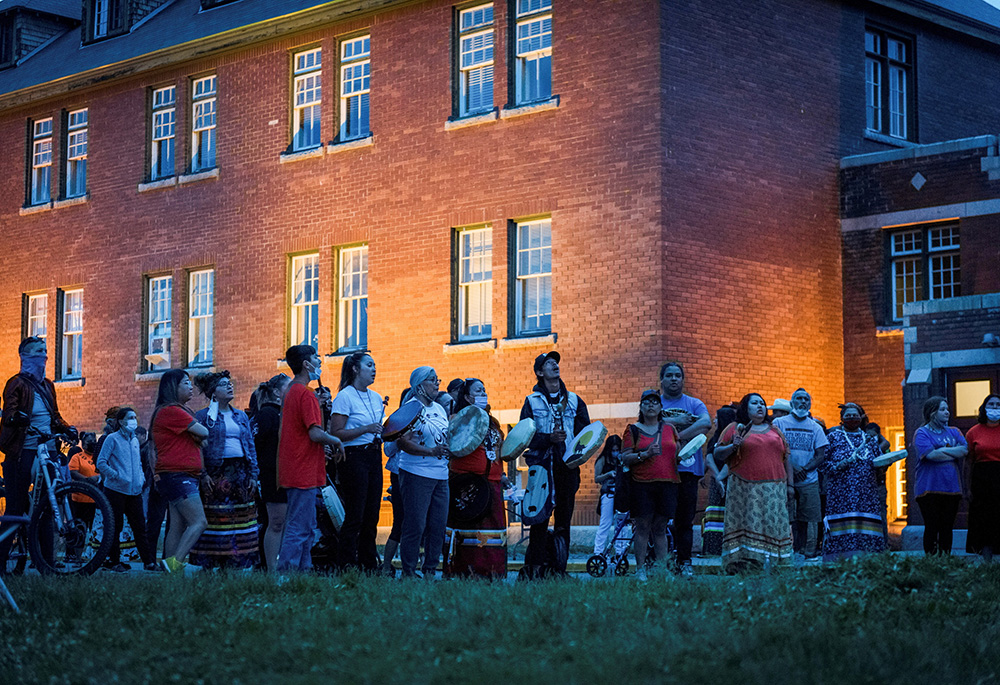
Kamloops residents and First Nations people gather to listen to drummers and singers at a memorial in front of the former Kamloops Indian Residential School in British Columbia, May 31, 2021. (CNS/Reuters/Dennis Owen)
It also put the Sisters of St. Ann, the congregation that helped administer Kamloops, in the eye of the storm, a spot they had hoped to leave for good in recent years.
Residential schools are an example of "structural sin," in which "people who are good, doing their best, can be part of something that in itself has very destructive impacts," said board chair Zarowny.
But being unaware doesn't absolve the congregation from responsibility and from fostering healing and reconciliation, she added. That's why it supports various education-focused organizations, as well as Returning to Spirit, an Indigenous-led, not-for-profit group that was co-founded by a Sister of St Ann and has been running reconciliation workshops for two decades.
After the Kamloops discovery, however, the congregation came under fire over the handling of its archives. Critics said it was not willing to share records that could help identify missing children. Sisters said they had met obligations by providing them to the TRC.
The sisters agreed to give the Royal British Columbia Museum full responsibility for their records and to fund a dedicated archivist job to make the information accessible within the museum.
"There are lots of things that have been set in motion that still need to be completed," Zarowny said. "Reconciliation is a process that will be ongoing. Is it ever done? Of course not. Is our country ever reconciled? No. Will it ever be? We will move along the spectrum, I think."








